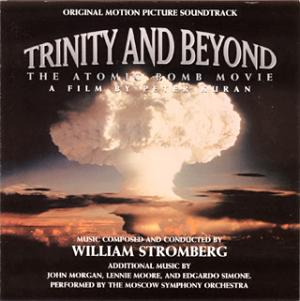Trinity and Beyond – The Atomic Bomb Movie
Music composed and conducted by William Stromberg
With additional music by John Morgan, Lennie Moore and Edgardo Simone
Performed by the Moscow Symphony Orchestra
Available on: Visual Concept Entertainment VCECD 01
Running Time: 57:37
Amazon US

William Stromberg is best known for his conducting and partnership with score restoration specialist John Morgan in Marco Polo's celebrated Classic Film Scores Series. Together the team have also recently scored the cable TV sequel Starship Troopers 2: Hero of the Federation (2004).
Here Stromberg tackles a big theme; music for a film about the development of the Atomic Bomb and the dawn of Trinity – the Birth of the Atomic Age.
Stromberg uses a large orchestra, dense scoring and imaginative orchestrations including colourful percussion - most especially the wooden block. His music covers many moods of war and its tragic consequences and moral dilemmas. The score embraces many styles and influences from brutal quasi-military, often Shostakovich-like material (e.g. 'Russia Gets the Bomb'), to 1950s sci-fi horror music, and from something of Herrmann in Hitchcock mode, to something of Borodin, and something, too, of 1940s film noire scores.
The heavy choral/orchestral writing in 'Hiroshima/Nagasaki' Requiem, for instance, is reminiscent of Prokofiev's Alexander Nevsky. Yet in this track, and elsewhere, there is also material recalling Hollywood 'Biblical' scores of the 1950s. Appropriately there is also material in 'Fat Man and Little Boy' that suggests the crushing, unrelenting Japanese war machine. Tracks like 'Aramada Annihilation', 'The George Device', 'Operation Wigwam' and, especially, 'Cherokee Deliverable H-Bomb' are overtly Holstian in their unrelenting menace and viciousness. The tracks' titles, tracing the development and proliferation of 'The Bomb' leave little scope for other than hard-hitting military music. 'Christmas Island Tests' give a little respite in presenting some Far Eastern ethnic folk-style music.
Without having seen the film, a little more balance towards music expressive of the tragedy of the bomb and the waste and futility of war would have been preferred. What there is in this mood seems too fleeting to make any sort of impact. A certain sort of horrific beauty is implied in celestial music of sorts, with women's chorus for 'Russian Monster Bomb'.
An exhausting hour of heavily scored, driven, big orchestral militaristic music; derivative but exciting enough and powerfully delivered by a very experienced film music specialist.
Ian Lace
3
More Music for the Atomic Bomb:
Atomic Journeys – Nukes in Space
Music by William Stromberg and John Morgan
Performed by the Moscow Symphony Orchestra
Available On: Visual Concept Entertainment VCECD 02
Running Time: 61:37
Amazon US

This compilation is a companion album to William Stromberg's Trinity and Beyond, reviewed above. It is also scored for a large Moscow Symphony Orchestra. Atomic Journeys comprises 27 cues, mostly 1 to 2 minutes long: Nukes in Space has 13 tracks of about the same length; and there is one bonus track 'Atomic Filmmakers'.
In this album there is more of a sense of inconsolable loss and the tragedy of war. As might be expected much of the music is wild and barbarous, and of it often speaks of desolation and despair. Some tracks have Far Eastern or Russian colourings. The scoring again is dense and the orchestration colourful and imaginative ('Vela Uniform', the most significant track of Atomic Journeys, extraordinarily suggestive of aerial combat for instance. Another notable track is 'Faultless' that sounds like a tortured nightmarish samba).
The composing honours are this time more equally shared between Morgan and Stromberg, The music on this album is less obviously derivative, more imaginative. The more obvious influence is Bernard Herrmann; 'Alaskan Wasteland' is reminiscent of Psycho, for instance. Ralph Vaughan Williams's Sinfonia Antarctica came to mind when I heard 'Frenchman Flats' and 'Ice Cap'.
Nukes in Space has something of a celestial beauty ('Peaceful Space') mixed with the horror. Again the influences are something of a fusion of 1950s Hollywood fantasy and horror à la Herrmann (especially 'Factory Workers'), as well as Holst and Vaughan Williams. 'The V-2 March' and 'Military Buildup' are reminiscent of Shostakovich. That is not to say that there is any dearth of originality here – 'Atomic Pizzicato' with its jazzy dialogue between piano and pizzicato strings is cheekily amusing welcome light relief. Two moods, 'Calm before the storm' and 'Quiet Intensity', are quite affecting.
This is powerful if often derivative music, but with some quite original material for a fearsome subject.
Ian Lace
31/2
Return to Index